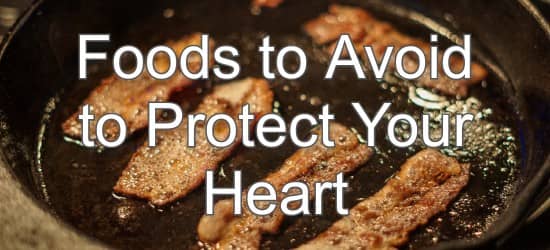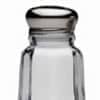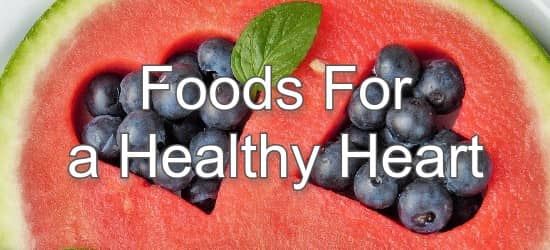Foods to Avoid to Protect Your Heart

A heart-healthy diet is a balanced and varied diet, high in plant foods and based on whole, unprocessed foods. It should include plenty of fruits, vegetables, whole grains, pulses, nuts, seeds, and fish (if eaten). Processed foods, red meat, and foods high in saturated fats should be minimized.
Heart disease is a leading cause of death in the world. There are also some specific foods, food ingredients, and food groups that are particularly harmful to the health of the cardiovascular system.
They cause harm in several ways: by raising blood pressure, increasing cholesterol levels, damaging blood vessels, or promoting harmful processes in the body, such as oxidation and inflammation.
Limit and avoid the following foods to protect your heart.
Foods to Avoid to Protect Your Heart
-
1. Salt
 A diet with too much salt (sodium) increases blood pressure, and high blood pressure is a risk factor for stroke and cardiovascular disease (1,2). There is also some evidence that salt can directly damage blood vessels, the heart, and other organs (3). The vast majority of salt in our diets comes from processed foods, which account for around 75% of the total salt we consume (only 25% comes from the salt we add to food ourselves). Reducing processed foods is therefore the best way to reduce your salt intake. The WHO recommends no more than 5g of salt per day for adults.
A diet with too much salt (sodium) increases blood pressure, and high blood pressure is a risk factor for stroke and cardiovascular disease (1,2). There is also some evidence that salt can directly damage blood vessels, the heart, and other organs (3). The vast majority of salt in our diets comes from processed foods, which account for around 75% of the total salt we consume (only 25% comes from the salt we add to food ourselves). Reducing processed foods is therefore the best way to reduce your salt intake. The WHO recommends no more than 5g of salt per day for adults. -
2. Trans (Hydrogenated) Fats
 The WHO estimates that trans fats are the cause of 540,000 deaths every year (4) and they are strongly linked to an increased risk of cardiovascular disease (5,6,7). Some countries have made them illegal as they are so damaging. They are produced industrially when liquid vegetable oils are hydrogenated, turning them into a solid fat and extending their shelf-life. They alter the way cells behave, resulting in unfavourable changes including raised cholesterol and weight gain. Check food labels for hydrogenated or partially hydrogenated fats.
The WHO estimates that trans fats are the cause of 540,000 deaths every year (4) and they are strongly linked to an increased risk of cardiovascular disease (5,6,7). Some countries have made them illegal as they are so damaging. They are produced industrially when liquid vegetable oils are hydrogenated, turning them into a solid fat and extending their shelf-life. They alter the way cells behave, resulting in unfavourable changes including raised cholesterol and weight gain. Check food labels for hydrogenated or partially hydrogenated fats. -
3. Processed meat
 Regular consumption of processed meat is linked with an increased risk of cardiovascular disease, obesity, diabetes, and some cancers (8,9,10,11). Processed meats are high in several harmful components including salt, saturated fat, and nitrates. They are often low quality, being composed of the parts left after the usual cuts of meat have been taken from the animal. For cardiovascular and overall health, it is advisable to avoid processed meats such as ham, bacon, salami, hotdogs, burgers, luncheon meats, beef jerky, and sausages.
Regular consumption of processed meat is linked with an increased risk of cardiovascular disease, obesity, diabetes, and some cancers (8,9,10,11). Processed meats are high in several harmful components including salt, saturated fat, and nitrates. They are often low quality, being composed of the parts left after the usual cuts of meat have been taken from the animal. For cardiovascular and overall health, it is advisable to avoid processed meats such as ham, bacon, salami, hotdogs, burgers, luncheon meats, beef jerky, and sausages. -
4. Red meat
 Frequent consumption of red meat is also linked with various negative health outcomes, including an increased risk of heart disease (10,11). One study estimated that eating 100g red meat per day (an average steak weighs around 200g), leads to an 11% increased risk of stroke and 15% increased risk of cardiovascular deaths (12). Red meat is a source of saturated fat, present in varying amounts, depending on the variety and cut of the meat. If you do consume red meat, it is advisable to limit it to a maximum of twice per week.
Frequent consumption of red meat is also linked with various negative health outcomes, including an increased risk of heart disease (10,11). One study estimated that eating 100g red meat per day (an average steak weighs around 200g), leads to an 11% increased risk of stroke and 15% increased risk of cardiovascular deaths (12). Red meat is a source of saturated fat, present in varying amounts, depending on the variety and cut of the meat. If you do consume red meat, it is advisable to limit it to a maximum of twice per week. -
5. Processed and ultra-processed foods
 High consumption of processed and especially ultra-processed foods is linked with an increased risk of cardiovascular disease, stroke, and high blood pressure (13,14). These are highly processed foods, designed by the food industry to be highly palatable, usually due to a combination of sugar, salt, fat (saturated and trans), flavorings, flavor enhancers, sweeteners, and other artificial additives (15). They typically contain no or very few beneficial nutrients, just empty calories. Examples include ready meals, fast foods, packaged bread, cakes and biscuits, packaged cereals, many snack foods, candy and confectionary, instant noodles, and soft drinks.
High consumption of processed and especially ultra-processed foods is linked with an increased risk of cardiovascular disease, stroke, and high blood pressure (13,14). These are highly processed foods, designed by the food industry to be highly palatable, usually due to a combination of sugar, salt, fat (saturated and trans), flavorings, flavor enhancers, sweeteners, and other artificial additives (15). They typically contain no or very few beneficial nutrients, just empty calories. Examples include ready meals, fast foods, packaged bread, cakes and biscuits, packaged cereals, many snack foods, candy and confectionary, instant noodles, and soft drinks. -
6. Saturated fat
 A diet high in saturated fat is associated with elevated cholesterol levels and risk of heart disease (16). Although there has been some debate in recent years over this association, the guidelines still recommend that saturated fat should account for no more than 10% of total calorie intake (17) (or just 5-6% according to the American Heart Association). Replacing saturated fats with mono and polyunsaturated fats (olive oil, avocado, oily fish, nuts, seeds etc.) produces the most benefit (18). The main sources of saturated fats are fatty meats, animal fats (lard, tallow, suet), full-fat dairy, pastry, and other baked goods, sauces, palm oil, fast foods, and fried foods.
A diet high in saturated fat is associated with elevated cholesterol levels and risk of heart disease (16). Although there has been some debate in recent years over this association, the guidelines still recommend that saturated fat should account for no more than 10% of total calorie intake (17) (or just 5-6% according to the American Heart Association). Replacing saturated fats with mono and polyunsaturated fats (olive oil, avocado, oily fish, nuts, seeds etc.) produces the most benefit (18). The main sources of saturated fats are fatty meats, animal fats (lard, tallow, suet), full-fat dairy, pastry, and other baked goods, sauces, palm oil, fast foods, and fried foods. -
7. Sugar
 Consuming a diet high in added sugars leads to weight gain, which is a key risk factor for cardiovascular disease (19). In addition, a high sugar diet promotes inflammation in the body, which is a harmful process involved in the development of heart disease and many other diseases (20). Furthermore, when sugar reacts with certain body tissues, it can lead to the formation of advanced glycation end products (aptly named AGEs). This results in cells becoming stiff and prone to damage, along with premature aging in the body and an increased risk of cardiovascular problems (21).
Consuming a diet high in added sugars leads to weight gain, which is a key risk factor for cardiovascular disease (19). In addition, a high sugar diet promotes inflammation in the body, which is a harmful process involved in the development of heart disease and many other diseases (20). Furthermore, when sugar reacts with certain body tissues, it can lead to the formation of advanced glycation end products (aptly named AGEs). This results in cells becoming stiff and prone to damage, along with premature aging in the body and an increased risk of cardiovascular problems (21). -
8. Deep Fried Foods
 Eating fried and deep-fried foods has been linked with a higher risk of high blood pressure (22), heart disease (23), coronary artery disease (24), and heart failure (25). In particular, there is evidence of harm from regular consumption of fried chicken and fried fish (26,27). When cheap oils are heated to very high temperatures and re-used, which is common practice with deep-fried foods made at home or in restaurants and takeaways, trans fats are also created. Deep-fried foods tend to also have substantial amounts of sugar and salt added to them, making them even worse. Common deep-fried foods include fried chicken, chicken wings, donuts, battered fish, chips, French fries, onion rings, Indian snack foods (samosa, pakora etc.).
Eating fried and deep-fried foods has been linked with a higher risk of high blood pressure (22), heart disease (23), coronary artery disease (24), and heart failure (25). In particular, there is evidence of harm from regular consumption of fried chicken and fried fish (26,27). When cheap oils are heated to very high temperatures and re-used, which is common practice with deep-fried foods made at home or in restaurants and takeaways, trans fats are also created. Deep-fried foods tend to also have substantial amounts of sugar and salt added to them, making them even worse. Common deep-fried foods include fried chicken, chicken wings, donuts, battered fish, chips, French fries, onion rings, Indian snack foods (samosa, pakora etc.).
Lifestyle Factors to Avoid to Prevent Heart Disease
- Weight gain - maintaining a healthy weight is one of the best ways to reduce your risk of heart disease. Keeping your BMI at the lower end of the healthy range, at around 20 or 21 will give you the lowest risk.
- Sedentary lifestyle - sitting down for long periods is detrimental to overall and cardiovascular health. Just getting up and walking around every hour (or even better every half hour) is beneficial (set an alarm while you get into the habit) and performing tasks standing instead of sitting whenever possible. For example, walk around while on the phone and try a standing desk if you have a desk job.
- Smoking - still the leading cause of preventable deaths and increases the risk of cardiovascular disease as well as many other health problems.
- Alcohol - a small glass of red wine may have some benefits, but drinking more than this increases your risk of cardiovascular and other health problems.
- Stress - stress is another key risk factor for cardiovascular problems, so including stress-relieving techniques such as exercise, yoga, meditation or breathing exercises is beneficial.
Related
Data Sources and References
- Rust P, Ekmekcioglu C. Salt Reduction to Prevent Hypertension and Cardiovascular Disease: JACC State-of-the-Art Review Adv Exp Med Biol. 2017;956:61-84. doi: 10.1007/5584_2016_147. 27757935
- Fodor JG, Whitmore B, Leenen F, Larochelle P. Salt and high blood pressure CMAJ. 1999 May 4;160(9 Suppl):S29-34. 10333851
- Robinson AT, Edwards DG, Farquhar WB. Dietary sodium and health: more than just blood pressure Curr Hypertens Rep. 2019 Apr 25;21(6):42. doi: 10.1007/s11906-019-0948-5. 31025198
- [No authors listed] Impact of Nonoptimal Intakes of Saturated, Polyunsaturated, and Trans Fat on Global Burdens of Coronary Heart Disease J Am Heart Assoc. 2016 Jan 27;5(1):e002076. doi: 10.1161/JAHA.115.002076. 26819249
- Veerman JL. Intake of saturated and trans unsaturated fatty acids and risk of all cause mortality, cardiovascular disease, and type 2 diabetes: systematic review and meta-analysis of observational studies BMJ. 2015 Sep 15;351:h4671. doi: 10.1136/bmj.h4671. 26374615
- Remig V, Franklin B, Margolis S, Kostas G, Nece T, Street JC. Trans fatty acids and lipid profile: A serious risk factor to cardiovascular disease, cancer and diabetes J Am Diet Assoc. 2010 Apr;110(4):585-92. doi: 10.1016/j.jada.2009.12.024. 20338284
- Hayes KC, Pronczuk A. New data on harmful effects of trans-fatty acids J Am Coll Nutr. 2010 Jun;29(3 Suppl):253S-284S. doi: 10.1080/07315724.2010.10719842. 20823487
- Zhong VW, Van Horn L, Greenland P, Carnethon MR, Ning H, Wilkins JT, Lloyd-Jones DM, Allen NB. Trends in Processed Meat, Unprocessed Red Meat, Poultry, and Fish Consumption in the United States, 1999-2016 JAMA Intern Med. 2020 Apr 1;180(4):503-512. doi: 10.1001/jamainternmed.2019.6969. 32011623
- Zhong VW, Van Horn L, Cornelis MC, Wilkins JT, Ning H, Carnethon MR, Greenland P, Mentz RJ, Tucker KL, Zhao L, Norwood AF, Lloyd-Jones DM, Allen NB. Associations of Processed Meat, Unprocessed Red Meat, Poultry, or Fish Intake With Incident Cardiovascular Disease and All-Cause Mortality JAMA. 2019 Mar 19;321(11):1081-1095. doi: 10.1001/jama.2019.1572. 30874756
- de Medeiros GCBS, Mesquita GXB, Lima SCVC, Silva DFO, de Azevedo KPM, Pimenta IDSF, de Oliveira AKDSG, Lyra CO, Martínez DG, Piuvezam G. Red and processed meat consumption and mortality: dose-response meta-analysis of prospective cohort studies Crit Rev Food Sci Nutr. 2023;63(27):8443-8456. doi: 10.1080/10408398.2022.2058461. Epub 2022 May 1. 35491892
- Wolk A. Health Risks Associated with Meat Consumption: A Review of Epidemiological Studies J Intern Med. 2017 Feb;281(2):106-122. doi: 10.1111/joim.12543. Epub 2016 Sep 6. 27597529
- Rohrmann S, Linseisen J. Potential health hazards of eating red meat Proc Nutr Soc. 2016 Aug;75(3):233-41. doi: 10.1017/S0029665115004255. Epub 2015 Dec 1. 26621069
- Elizabeth L, Machado P, Zinöcker M, Baker P, Lawrence M. Consumption of ultra-processed foods and health outcomes: a systematic review of epidemiological studies Nutrients. 2020 Jun 30;12(7):1955. doi: 10.3390/nu12071955. 32630022
- Fiolet T, Srour B, Sellem L, Kesse-Guyot E, Allès B, Méjean C, Deschasaux M, Fassier P, Latino-Martel P, Beslay M, Hercberg S, Lavalette C, Monteiro CA, Julia C, Touvier M. Ultra-processed food intake and risk of cardiovascular disease: prospective cohort study (NutriNet-Santé) BMJ. 2018 Feb 14;360:k322. doi: 10.1136/bmj.k322. 29444771
- Ares G, Vidal L, Allegue G, Giménez A, Bandeira E, Moratorio X, Molina V, Curutchet MR. Ultra-processed foods: what they are and how to identify them Appetite. 2016 Oct 1;105:611-7. doi: 10.1016/j.appet.2016.06.028. Epub 2016 Jun 24. 27349706
- Hooper L, Martin N, Jimoh OF, Kirk C, Foster E, Abdelhamid AS. Reduction in saturated fat intake for cardiovascular disease Cochrane Database Syst Rev. 2020 Aug 21;8(8):CD011737. doi: 10.1002/14651858.CD011737.pub3. 32827219
- Dixon LB, Ernst ND. US dietary guidelines: is saturated fat a nutrient of concern? J Nutr. 2001 Feb;131(2S-1):510S-526S. doi: 10.1093/jn/131.2.510S. 11160582
- Hooper L, Martin N, Jimoh OF, Kirk C, Foster E, Abdelhamid AS. A systematic review of the effect of dietary saturated and polyunsaturated fat on heart disease Cochrane Database Syst Rev. 2020 Aug 21;8(8):CD011737. doi: 10.1002/14651858.CD011737.pub3. 32827219
- Schmidt LA. Added sugar intake and cardiovascular diseases mortality among US adults JAMA Intern Med. 2014 Apr;174(4):525-6. doi: 10.1001/jamainternmed.2013.12991. 24493006
- Olszewski PK, Wood EL, Klockars A, Levine AS. Impact of sugar on the body, brain, and behavior Curr Nutr Rep. 2019 Jun;8(2):120-128. doi: 10.1007/s13668-019-0270-5. 30945139
- Neviere R, Yu Y, Wang L, Tessier F, Boulanger E. Advanced glycation end products (AGEs) and cardiovascular dysfunction: focus on high molecular weight AGEs Glycoconj J. 2016 Aug;33(4):607-17. doi: 10.1007/s10719-016-9679-x. Epub 2016 Jun 8. 27277623
- Gomes JMG, Costa JDA, Alfenas RCG. Association between fried food consumption and hypertension in Korean adults Br J Nutr. 2018 Feb;119(4):422-430. doi: 10.1017/S0007114517003956. 29498351
- Patzer KH. Fried-food consumption and risk of cardiovascular disease and all-cause mortality: a meta-analysis of observational studies MMW Fortschr Med. 2021 Feb;163(3):3. doi: 10.1007/s15006-021-9640-1. 33591495
- Sayon-Orea C, Bes-Rastrollo M, Gea A, Zazpe I, Basterra-Gortari FJ, Martinez-Gonzalez MA. Fried-food consumption and risk of type 2 diabetes and coronary artery disease: a prospective study in 2 cohorts of US women and men Br J Nutr. 2014 Sep 28;112(6):984-91. doi: 10.1017/S0007114514001755. 25201306
- Djoussé L, Gaziano JM. Consumption of fried foods and risk of heart failure in the physicians' health study Circulation. 2008 Jan 29;117(4):512-6. doi: 10.1161/CIRCULATIONAHA.107.734210. Epub 2008 Jan 14. 18195171
- Nahab F, Pearson K, Frankel MR, Ard J, Safford MM, Kleindorfer D, Howard VJ, Judd S. Association of fried food consumption with all cause, cardiovascular, and cancer mortality: prospective cohort study Public Health Nutr. 2016 Dec;19(18):3327-3336. doi: 10.1017/S136898001600152X. Epub 2016 Jun 24. 27338865
- Ricci H, Gaeta M, Franchi C, Poli A, Battino M, Dolci A, Schmid D, Ricci C. Dietary fried fish intake increases risk of CVD: the REasons for Geographic And Racial Differences in Stroke (REGARDS) study Nutrients. 2023 Oct 26;15(21):4539. doi: 10.3390/nu15214539. 37960192
Simplify Nutrition Tracking with MyFoodData!
Speedy Tools and Detailed Data FREEEasily analyze your meals to find the best foods for your goals.
✅ Use our recipe nutrition calculator and nutrition comparison tool.
✅ Access expert nutrition data tools and in-depth articles.
✅ Log foods and organize your recipes with a free account.


 Next ➞
Next ➞
